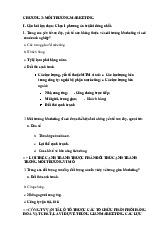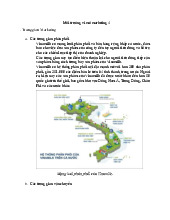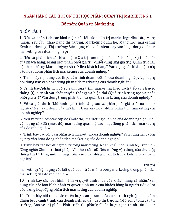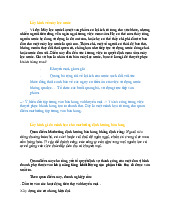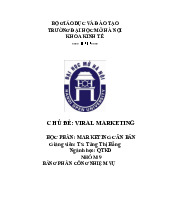






Preview text:
lOMoAR cPSD| 48302938 Course details Course name Marketing Research (MRE) Units of credit 3 Study length 15 weeks Prerequisite /Co requisite PAS + PMK Suggested study commitment
Approximately 15 hours per week Year 2023 Minh-Duong Nguyen Email: duongnm@hanu.edu.vn Lien Nguyen Phuong Course Coordinator/Lecturer Email: liennp@hanu.edu.vn
Please put [MRE] and your name or student number in the subject line of ALL e-mail to me R.201 Building C Contact details Tel: (024) 355 33 560 Course aim/rationale
This course is a study of research methods and techniques applied to solve problems in marketing such as market needs
identification, customers’ perception of product design, channel of distribution, pricing, and promotion, or measuring
customer satisfaction, etc... In this course, students learn to identify research problem, set research objectives, select
appropriate research design. Students learn to develop skills to design survey questionaire, collect data, analyze data, and
present the research report. Attention is also given to social and ethical issues in marketing research.
Course learning objectives (LOs)
This course is designed to provide students with understanding of marketing research with regard to what to research, why,
and how to do the marketing research.
On completion of the course, students should be able to:
LO1: Demonstrate an understanding of the role and value of marketing research in business context.
LO2: Identify marketing problems and translates into research questions.
LO3: Differentiate research paradigms and designs.
LO4: Determine sample size, design Interview protocols, and conduct interviews.
LO5: Be competent in using data collection instruments, and data analytical tools.
LO6: Draw on research findings to make relevant recommendations. LO7:
Present the final report in oral and written form. Course materials
Materials of Marketing Research course will include textbooks, industry and academic articles handed out in class. Also, the
students are encouraged to browse the university library, the Internet, Google Scholar etc… to get a profound and better
understanding of relevant academic literature, and relevant marketing research methodology for their research project. Course structure
The structure of this course for the mixed mode of online and on-campus students comprises: •
One 2.5 class hour lecture per week •
One 2.5 class hour tutorial per week lOMoAR cPSD| 48302938 Student Expectation •
The student is expected to participate in the course via F2F or Teams with the instructor, by reading the
assigned readings, doing tutorial exercises, and completing the project in a timely manner. Teams should be
checked daily for updated information. •
Email correspondence should indicate that the student understands common business etiquette. Include your
name and course name in every email, reply to emails by including the original email in addition to your
comments or questions. Avoid grammatical and spelling errors.
Prescribed textbook: Burns, A.C., Veeck, A. and Bush, R.F (2017), Marketing Research, 8th ed., Pearson, England
Proposed weekly schedule (*): Week Date Chapters Lecture Tutorial activities 1 13 Jan 1, 2,3
Introduction to Marketing Research
Group assignment brief
The Marketing Research industry
Referencing style (Harvard style)
The Marketing Research process Group formation (**) 2 20 Jan 4,5 Research design: qualitative and
Research structure guide Research
quantitative research Ethical issues in problem Research 3 27 Jan 6 Secondary analysis
Secondary analysis: Buzzsumo/Fanpage Social media analysis and
Karma/Nvivo/Google trend content analysis
Population size estimate 4 3 Feb 6
Qualitative research: In-depth interviews Literature review (Online) and Focus group discussions
Interview protocol practice 5 24 Feb Handouts Qualitative data analysis
Interview protocol practice Consultation 6 2 Mar 8 Understanding measurement, the Coding guide 1 developing
Interview protocol submission: 29 Feb questions, and designing (23:59) questionnaire 7 9 Mar 9 Sampling methodologies
Coding guide 2 – In-depth Interview comments in class
First In-depth Interview submission: 7 Mar (23:59) 8 16 Mar Data collection Data collection
Students do fieldwork.
Data collection submission: 19 Mar (23:59) 9 23 Mar 12, 13, 14 Quantitative analysis Consultation 10 30 Mar
In class mid-term test (60’) Consultation 11 6 Apr 16 The research reports Consultation
Industry engagement (tentative) 12 13 Apr All chapters Revision Group presentation Reflection guide
Slide submission due date: 10 Apr (23:59)
Reflection submission due date: 17 Apr (23:59)
(*) The schedule is subject to change.
(**) If you are absent in the first tutorial, you will be assigned to a group randomly. 2 lOMoAR cPSD| 48302938 Assessment
Assessment for the subject will include: 1 Participation (Individual) Required assessment: Yes 10% 2 Mid-term test (Individual) Required assessment: Yes 20% 3 Data collection (Individual) Required assessment: Yes 15% 4 Project report (ppt) (Group) Required assessment: Yes 35% 5 Project presentation (Group) Required assessment: Yes 05% 6 Reflection (Individual) Required assessment: Yes 15% Total 100% Details of assessment
1. Participation (Individual) - 10%
Students are expected to be present in Lectures and Tutorials. If you are absent for more than 3 lectures or 3 tutorials, you
will not be eligible to pass the course. Also, active participation in class will be counted toward the final participation mark.
If you are not present when your tutor/lecturer checks attendance, you will be marked absent.
You must sign the exam list at the end of the course by yourself. Any violations on this leads to the failure of the course.
2. Mid-term test (Individual) – 20%
The mid-term test will be a 60-minute in-class test and it includes only multiple-choice questions. There will be NO make-
up test except for eligible and documented reasons. In this case, the make-up test will be oral test. The midterm test includes
one case study. Three cases will be given to you at least one day before the test. The case will be selected randomly from
three given cases. The format of the test is subject to change.
3. Data collection (Individual) – 15%
You must collect data as required (2 In-depth interviews/student). Interviews must be transcribed in an Excel file, each line
is for one sentence; and you need four columns including line number, text, code, and category. Your data collection
submission includes audio recording in mp3, wma, or wav, transcript with guided format, and picture of respondents taken by interviewers.
The file names follow below structures:
Audio/transcript/picture_yourname_yourstudentID_DateofIDI_nameofrespondents_locationofIDI_timeofIDI
E.g: Audio_NguyenVanA_204050007_13.04.2021_NguyenThiHong_HaDong_15.23_15.45 Technical 11.25-15 9.75-11.25 8.25-9.75 6.75-8.25 0-6.75 Total mark skills IDIs
Extensive evidence of Significant Clear evidence Evidence of Little or no 15
the appropriate selection evidence of of the appropriate evidence of and highly skilful the appropriate selection of appropriate techniques,
execution of techniques. appropriate selection selection of which may
Application of skills may selection and and techniques, and require more lead to conceptual skilful execution significant gaps skilful advances within the execution of of in skill execution. topic. techniques. techniques. execution. The format for a transcript: 3 lOMoAR cPSD| 48302938 Line number Text Code Category 1 First sentence
The codebook example: https://www.evalacademy.com/articles/creating-a-qualitative-codebook
4. Project (Group) – 40%
Each group of 5-6 students will take charge of a project, which runs throughout the semester. The team should work well all
the time, ensure constant communication. Every member of the team must contribute to the project and be respectful to each other.
Brief description of project
You are a team of junior executives at a reputable marketing agency. You are assigned to support a client in understanding
its consumers by doing qualitative research, which focuses on your assigned topic. You must define the research problems,
research design, sample, and data collection, and perform the research. Afterward, a detail analysis and recommendation
presented in PowerPoint slides will be presented to the client. Your group will be assigned to a brand and a topic randomly.
Each student will conduct two in-depth interviews with consumers. You must make sure that one interviewee participates
in one and only one IDI. Each group will have to analyse all your groups’ IDIs. Brand Topic Honda Brand loyalty Toyota Brand reputation Oral-B Brand experience Shiseido Brand identity The Face Shop Brand promise X-Men Brand personality
4.1 Report (Group) – 35%
The structure of the final report is as below. You are expected to perform actual analysis from IDIs. Each group just must do
the report in the form of slides. The report is submitted via Turnitin. Submission outside Turnitin will not be evaluated. There
is no limit in number of slides. Slides must be numbered. Assessment criteria Note Mark (35) Brand introduction
The problem should be clearly clarified. You must use social media 7.5 Brand problem
analysis/content analysis to support your problem identification. Research questions
Research objectives must be SMART. 3 and Research Objectives Conceptual and operational 3 definitions. Target audience’s
You should show how you calculate the population size. Sample size must 2
characteristics and population be specified. estimate. Research method 2 Ethical concerns related to research methods should be discussed. Sample design and 2 Data collection Timeline
From the date of the proposal till the date of delivery. 1.5 Findings 7.5 Managerial implications 3 Conclusions and limitations 1.5 References
You must follow Harvard style. Guide is as below: 2
https://www.lib.rmit.edu.au/easy-cite/?styleguide=styleguide-1#stn-0 4 lOMoAR cPSD| 48302938 Rubrics Assessment criteria Needs improvement Good Excellent (80- (≤60%) (60 - 80%) 100%) Brand introduction
Too brief or too lengthy. Do not Provide the business managers an Provide the business managers a Brand problem (7.5 point)
provide the business managers overview of the main parts of the succinct overview of the main parts
an overview of the main parts of report. of the report. the report. Research objectives
Demonstrates no or limited Provide clear research objectives Provide very clear research Research question
ability to provide clear research and relevant research question(s) objectives and relevant research
objectives and relevant research or hypotheses. question(s) or hypotheses. (3 point)
Able to evaluate the timeliness and question(s). significance of the project. Definitions (3 point)
Weak review of key papers Clear review of key papers related Demonstrate evidence of extensive - Conceptual
and related to the research project. to the research project.
research and a depth of thinking Demonstrate evidence
of through critical review of key operational definition
extensive research of previous papers related to the research studies. project.
Build up a conceptual framework from published theories or constructs to present
the overall structure of the study. Methodology (7.5 points) Inappropriate
research Appropriate research methods. Appropriate research methods. - Target audience methods. Inappropriate Identify previous studies
to Extensive research on previous sampling.
support the selected methods and studies that support the selected - Research method Incompetent in
instruments for this research. methods and instruments for this - Ethical concerns statistical Appropriate sampling. research. -
Sample design and data analysis techniques
Good command of statistical Appropriate sampling, evidence of analysis techniques. collection
effective field work to collect data. Competent use of statistical - Timeline analysis techniques. Research findings
and No findings or weak findings Provide descriptive outcomes. Effectively present descriptive are presented. outcomes, compare information interpretations (7.5 points)
Few interpretations of research No or few interpretations are
from different groups of variables. findings are provided. provided.
Able to evaluate the reliability, validity, and accuracy of the research findings.
Effective interpretation of the
implications of research findings. Recommendations No recommendation
or Relevant recommendations to the Insightful discussion of Conclusions irrelevant
recommendations. research problems are provided. the relationship between
the research findings and research Limitations (4.5 point)
No summary of all parts of the Attempt to summarize all parts of question(s). Recommend relevant project. the project.
solutions to the research problems.
Nicely connect all parts of the project. References (2 point)
References and in-text citation
All references and in-text citation Good sources of academic and errors detract
follow Harvard style. At least 7 industry reference. At least 10 significantly from
academic references are listed.
academic references are listed. All Harvard style.
references and in-text citation follow Harvard style.
4.2 Project presentation (Group) – 5%
Presentation will be no more than 15 minutes following by 5 minutes Q&A session.
Detailed presentation guidance will be delivered in the tutorial classes. Presentation marking rubrics: Group number: Tutorial: Project title: Oral Presentation 3.75-5 3.25-3.75 2.75-3.25 2.25*2.75 0-2.25 Total Skills mark 5 lOMoAR cPSD| 48302938 Flow and Content Message and Message and Message and Message and Message and/or 5 Strong Start and Finish, medium are medium are medium
are medium may not medium are not Clear story, Clear
highly relevant relevant to the mostly relevant be totally relevant to the relevance to client, to the topic. The to the topic. The topic. The relevant to the topic. The Clear differentiation communication points, Appropriate communication communication is clear topic. The communication visuals, Delivery within is consistently is mostly clear and communication is not clear and allocated time,
clear and highly and persuasive. mostly
is clear but not not persuasive. Engagement with persuasive persuasive. persuasive. audience, Questions answered appropriately. 4.3. Teamwork
During group work, the group must arrange the work by themselves, which include work allocation, meetings, and other
works that help projects done successfully. In case there is any dispute or lack of contribution of members, your group must
inform lectures/tutorials as soon as possible. The latest for the information is one day after your presentation. Otherwise, all
claims are discarded. In case, you are reported to not contribute to group work, you have one day to claim with evidence.
5. Reflection (Individual) – 10%
We request you to reflect on your experience related to the creation of a specific research material used by your team, and to
establish a connection between that experience and a fundamental principle of conducting ethical research. The reflection
should not be more than 600 words. The reflection should follow DIEP model. Below materials could help you. DIEP model:
https://students.unimelb.edu.au/academic-skills/resources/developing-an-academic-
writing-style/reflective-writing
https://www.youtube.com/watch?v=SntBj0FIApw&t=5s
Ethics in Qualitative research:
https://www.qualitative-research.net/index.php/fqs/article/view/3155/4306 Reflection 8-10 7-8 6-7 5-6 0-5 Total marks - Include Extensive Significant
Clear evidence of Some evidence Little or no 10 clear description of
evidence of ability evidence of ability ability to critically of ability to evidence of a decision or
to critically engage to critically engage engage in analysis critically engage ability to moment you in analysis of own in analysis
of of own skills and in analysis of critically engage experienced skills and analysis of own knowledge and creating research knowledge and skills and analysis of own skills and in analysis of materials (YOUR analysis of knowledge and performance/outc knowledge in own skills and EXPERIENCE) performance/outc analysis of
omes relating to relation to the knowledge in - 1 relevant
omes relating to performance/outc the assignment assignment or relation to the principle of ethical the
assignment omes relating to objectives. Where context of the assignment or
conduct of research objectives. Where the assignment
brief. There may context of the is clearly required the objectives. Where articulated - required the analysis is be limited brief. No or Sophisticated analysis is required
the supported by an evidence of an poorly defined interpretation and supported by a analysis
is action plan that associated action action plan reflection on what detailed
and supported by a may require further plan or plan may provided if you might do clearly defined clearly defined detail or not clearly required. differently in the action plan. action plan. future / next phase clarification. address the key - Well written and issues. professionally presented with accurate/consistent referencing style
6. Late submission policy 6 lOMoAR cPSD| 48302938
If you submit late for any assessments, you will be deducted 10% for every 24 hours late (Note: 0.1 second late will be treated as 1 day late).
For example, for the report (40%):
If you submit 1 day late, you will be deducted 4%
If you submit 2 days late, you will be deducted 8%
If you submit 3 days late, you will be deducted 12% If you
submit 4 days late, your work will not be considered. _The end_ 7
